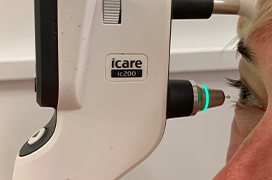Introduction: Intraocular pressure (IOP) measurement in patients with thyroid-associated orbitopathy (TAO) can be difficult and misleading, particularly in patients with diplopia and eye deviation (esotropia or hypotropia). However, when measuring IOP, it is also necessary to pay sufficient attention to TAO patients without diplopia in primary gaze direction and without motility disorder that might not be readily apparent.
Purpose: The aim of this study was to evaluate the accuracy of measurement of intraocular pressure (IOP) using three different types of tonometers: the rebound tonometer (iCARE), the Goldmann applanation tonometer (GAT) and the non-contact airpuff tonometer (NCT) in patients with inactive TAO.
Materials and Methods: A total of 98 eyes of 49 adult patients with TAO were examined. The study group included 36 females and 13 males, with an age range of 19–70 years and a median age of 55.0. All the patients had evidence of thyroid disease, a history of mild to moderate TAO, no clinical signs or symptoms of active disease, and no diplopia in direct gaze direction. In addition to a comprehensive eye examination, all the patients underwent measurement of intraocular pressure with three tonometers: NCT, iCARE, and GAT. The measurements with these three devices were compared.
Results: The mean IOP was 18.1 ± 2.4 mmHg (range 13–25 mmHg) with GAT, 22.3 ±5.0 mmHg (range 13–35 mmHg) with NCT, and 18.0 ±2.4 mmHg (range 13.3–26 mmHg) with iCARE. The mean difference between the GAT and iCARE measurements (using the Bland-Altman analysis) was -0.1
±1.16 mmHg (limits of agreement -2.4 to 2.1). The mean difference between the GAT and NCT measurements was 4.2 ±3.6 mmHg (limits of agreement -2.8 to 11.2). The mean difference between the iCARE and NCT measurements was -4.3 ±3.7 mmHg (limits of agreement -11.6 to 2.9). No significant difference was found between GAT and iCARE (p = 1.000). However, there was a significant difference between GAT and NCT (p < 0.0001), as well as between iCARE and NCT (p < 0.0001).
Conclusions: In patients with TAO, NCT significantly overestimates IOP values compared to the GAT and ICare. By contrast, the iCARE rebound tonometer provides IOP measurements comparable to the gold standard GAT in these patients.

